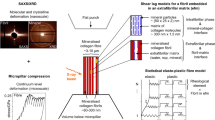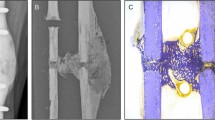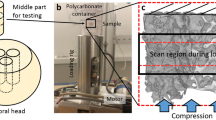Abstract
A mechanistic understanding of fracture in human bone is critical to predicting fracture risk associated with age and disease. Despite extensive work, a mechanistic framework for describing how the microstructure affects the failure of bone is lacking. Although micromechanical models incorporating local failure criteria have been developed for metallic and ceramic materials1,2, few such models exist for biological materials. In fact, there is no proof to support the widely held belief that fracture in bone is locally strain-controlled3,4, as for example has been shown for ductile fracture in metallic materials5. In the present study, we provide such evidence through a novel series of experiments involving a double-notch-bend geometry, designed to shed light on the nature of the critical failure events in bone. We examine how the propagating crack interacts with the bone microstructure to provide some mechanistic understanding of fracture and to define how properties vary with orientation. It was found that fracture in human cortical bone is consistent with strain-controlled failure, and the influence of microstructure can be described in terms of several toughening mechanisms. We provide estimates of the relative importance of these mechanisms, such as uncracked-ligament bridging.
This is a preview of subscription content, access via your institution
Access options
Subscribe to this journal
Receive 12 print issues and online access
$259.00 per year
only $21.58 per issue
Buy this article
- Purchase on Springer Link
- Instant access to full article PDF
Prices may be subject to local taxes which are calculated during checkout



Similar content being viewed by others
References
Ritchie, R.O., Knott, J.F. & Rice, J.R. On the relationship between critical tensile stress and fracture toughness in mild steel. J. Mech. Phys. Solids 21, 395–410 (1973).
Ritchie, R.O., Server, W.L. & Wullaert, R.A. Critical fracture stress and fracture strain models for the prediction of lower and upper shelf toughness in nuclear pressure vessel steels. Metall. Trans. A 10, 1557–1570 (1979).
Yeh, O.C. & Keaveny, T.M. Relative roles of microdamage and microfracture in the mechanical behaviour of trabecular bone. J. Orthopaed. Res. 19, 1001–1007 (2001).
Keyak, J.H. & Rossi, S.A. Prediction of femoral fracture load using finite element models: an examination of stress- and strain-based failure theories. J. Biomech. 33, 209–214 (2000).
Lewandowski, J.J. & Thompson A.W. in Advances in Fracture Research (Fracture 84): Proc. 6thInt. Conf. on Fracture (ed. Valluri, S. R.) 1515–1522 (Pergamon, New York, USA, 1984).
http://ttb.eng.wayne.edu/~grimm/ME518/L3F3.html, from Park, J.B. & Lakes, R.S. Biomaterials: An Introduction (Plenum, New York, USA, 1992).
Rho, J.Y., Kuhn-Spearing, L. & Zioupos, P. Mechanical properties and the hierarchical structure of bone. Med. Eng. Phys. 20, 92–102 (1998).
Weiner, S. & Wagner, H.D. The material bone: Structure-mechanical function relations. Annu. Rev. Mater. Sci. 28, 271–298 (1998).
Currey, J.D. 'Osteons' in biomechanical literature. J. Biomech. 15, 717 (1982).
Griffiths, J.R. & Owen, D.R.J. An elastic-plastic stress analysis for a notched bar in plane strain bending. J. Mech. Phys. Solids 19, 419–431 (1971).
Zioupos, P., Currey, J.D., Mirza, M.S. & Barton, D.C. Experimentally determined microcracking around a circular hole in a flat plate of bone: comparison with predicted stresses. Phil. Trans. R. Soc. Lond. B. 347, 383–396 (1995).
Lotz, J.C., Cheal, E.J. & Hayes, W.C. Fracture prediction for the proximal femur using finite element models: Part I - Linear analysis. J. Biomech. Eng. 113, 353–360 (1991).
Vashishth, D. et al. In vivo diffuse damage in human vertebral trabecular bone. Bone 26, 147–152 (2000).
Parsamian, G.P. & Norman, T.L. Diffuse damage accumulation in the fracture process zone of human cortical bone specimens and its influence on fracture toughness, J. Mater. Sci.: Mater. Med. 12, 779–783 (2001).
Vashishth, D., Tanner, K.E. & Bonfield, W. Contribution, development and morphology of microcracking in cortical bone during crack propagation J. Biomech. 33, 1169–1174 (2000).
Yeni, Y.N. & Norman, T.L. Calculation of porosity and osteonal cement line effects on the effective fracture toughness of cortical bone in longitudinal crack growth. J. Biomed. Mater. Res. 51, 504–509 (2000).
Wang, X., Bank, R.A., Tekoppele, J.M. & Agrawal, C.M. The role of collagen in determining bone mechanical properties. J. Orthopaed. Res. 19, 1021–1026 (2001).
Wang, X., Shen, X., Li, X. & Agrawal, C.M. Age-related changes in the collagen network and the toughness of bone. Bone 31, 1–7 (2002).
Thompson, J.B. et al. Bone indentation recovery time correlates with bond reforming time. Nature 414, 773–776 (2001).
Yeni, Y.N. & Fyhrie, D.P. in Proc. Bioeng. Conf. BED Vol. 50 293–294 (ASME, New York, USA, 2001).
Burr, D.B. The contribution of the organic matrix to bone's material properties. Bone 31, 8–11 (2002).
Shang, J.H. & Ritchie, R.O. Crack bridging by uncracked ligaments during fatigue-crack growth in SiC-reinforced aluminum-alloy composites. Metall. Trans. A 20, 897–908 (1989).
Campbell, J.P., Venkateswara Rao, K.T. & Ritchie, R.O. The effect of microstructure on fracture toughness and fatigue crack growth behaviour in γ-titanium aluminide based intermetallics. Metall. Mater. Trans. A 30, 563–577 (1999).
Phelps, J.B., Hubbard, G.B., Wang, X. & Agrawal, C.M. Microstructural heterogeneity and the fracture toughness of bone. J. Biomed. Mater. Res. 51, 735–741 (2000).
Lucksanambool, P., Higgs, W.A.J., Higgs, R.J.E.D. & Swain, M.W. Fracture toughness of bovine bone: influence of orientation and storage media. Biomater. 22, 3127–3132 (2001).
Zioupos, P. & Currey, J.D. Changes in the stiffness, strength, and toughness of human cortical bone with age. Bone 22, 57–66 (1998).
Behiri, J.C. & Bonfield, W. Orientation dependence on fracture mechanics of bone. J. Biomech. 22, 863–872 (1989).
Bilby, B.A., Cardew, G.E. & Howard, I.C. in Fracture 1977 (ed. Taplin, D. H. R.)Vol. 3 197–200 (Pergamon, Oxford, UK, 1978).
Cotterell, B. & Rice, J.R. Slightly curved or kinked cracks. Int. J. Fract. 16, 155–169 (1980).
Ritchie, R.O., Yu, W. & Bucci, R.J. Fatigue crack propagation in ARALL laminates: measurement of the effect of crack-tip shielding from crack bridging. Eng. Fract. Mech. 32, 361–377 (1989).
ASTM E 399–90 (Reapproved 1997). Annual Book of ASTM Standards, Vol. 03.01: Metals- Mechanical Testing; Elevated and Low-temperature Tests; Metallography (ASTM, West Conshohocken, Pennsylvania, USA, 2001).
Haggag, F.M. & Underwood, J.H. Compliance of a three-point bend specimen at load line. Int. J. Fract. 26, 63–65 (1984).
Acknowledgements
This work was supported by the National Institutes of Health under Grant No. P01DE09859 (for R.K.N.) and by the Office of Science, Office of Basic Energy Science of the Department of Energy under Contract No. DE-Ac03-76SF00098 (for R.O.R.). The authors wish to thank Christian M. Puttlitz (University of California, San Francisco) for supplying the human bone used in this study, Jamie J. Kruzic for assistance with the compliance measurements, and John W. Hutchinson for helpful discussion.
Author information
Authors and Affiliations
Corresponding author
Ethics declarations
Competing interests
The authors declare no competing financial interests.
Rights and permissions
About this article
Cite this article
Nalla, R., Kinney, J. & Ritchie, R. Mechanistic fracture criteria for the failure of human cortical bone. Nature Mater 2, 164–168 (2003). https://doi.org/10.1038/nmat832
Received:
Accepted:
Published:
Issue Date:
DOI: https://doi.org/10.1038/nmat832
This article is cited by
-
Whole-Bone Toughness Is Linked to Canal and Osteocyte Lacunae Deficits in the ZDSD Type 2 Diabetic Rat Model
JOM (2023)
-
Multiscale Effects of Collagen Damage in Cortical Bone and Dentin
JOM (2023)
-
Biomechanical analysis of different THA cementless femoral stem designs in physiological and osteoporotic bone during static loading conditions
Archives of Orthopaedic and Trauma Surgery (2023)
-
Fracture Toughness: Bridging the Gap Between Hip Fracture and Fracture Risk Assessment
Current Osteoporosis Reports (2023)
-
Unraveling the effect of collagen damage on bone fracture using in situ synchrotron microtomography with deep learning
Communications Materials (2022)



